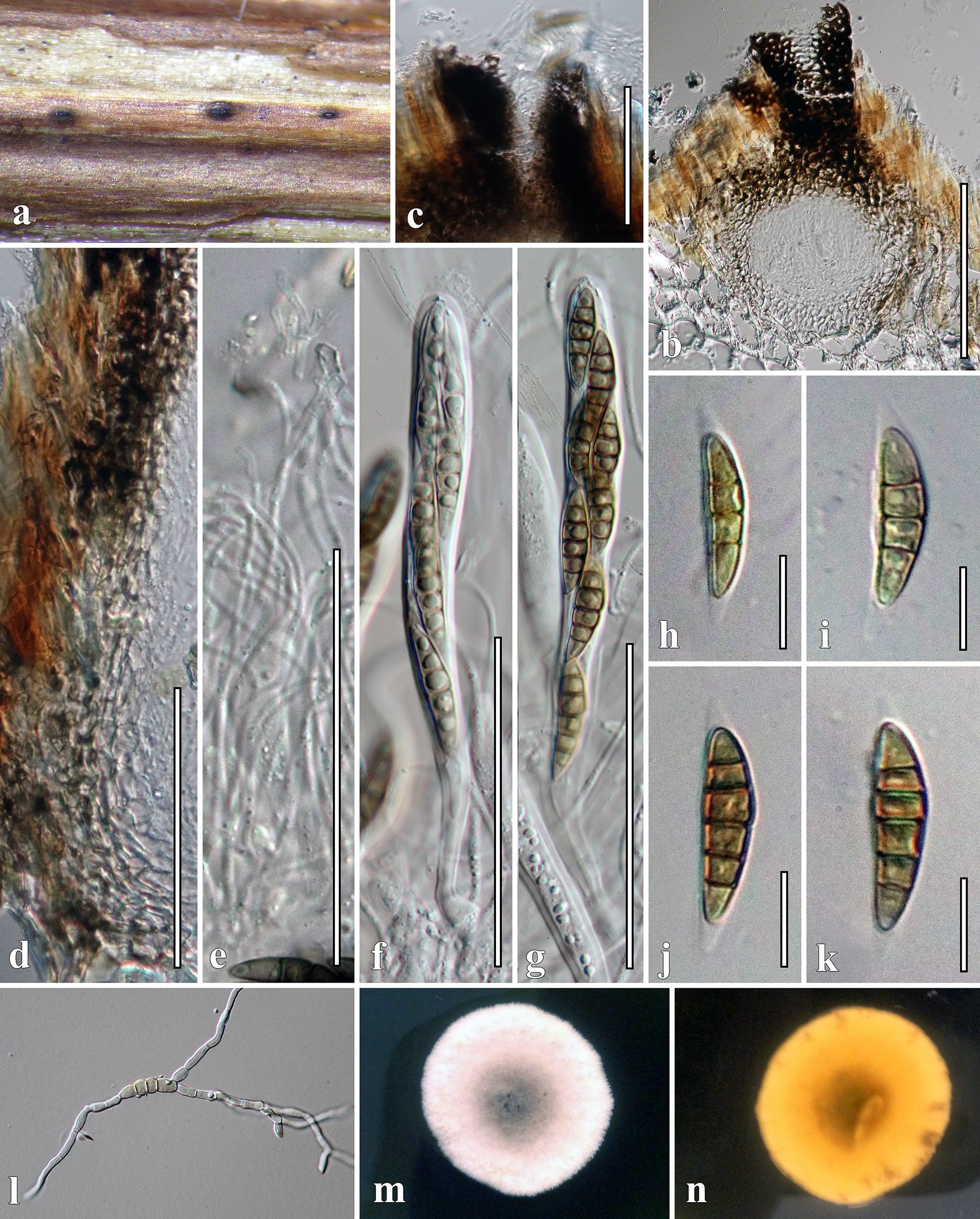 259
259
Sigarispora montanae Phukhams., Sue, K.D. Hyde 2020
Index Fungorum number: IF557124; Facesoffungi number: FoF 07295
Holotype: China, Yunnan Province, Dali District, on dead stems of Clematis montana, 20 May 2016, C. Phukhamsakda, CMCR1 (MFLU 20–0418, holotype); ex-type living culture, MFLUCC 16–0999.
Morphological description
Sexual morph: Ascomata 180–230 × 140–200 μm
( x̄ = 200 × 160 μm, n = 5), solitary, scattered, semiimmersed, with black shiny ostioles, globose, coriaceous, partial carbonaceous at the apex, dark brown to black, rough-walled, forming a clypeus like character, ostiolate. Ostioles (40–)70–100 × 30–60 μm ( x̄= 80 × 50 μm, n = 5), with a crest-like apex, central, elongated and laterally compressed, irregular wall, filled with hyaline periphyses. Peridium 13–30 μm wide ( x̄ = 20 μm, n= 30), wider at the apex, thinner at the base, with 6–7 layers of lightly pigmented light brown to dark brown, thick-walled cells of textura angularis, cells towards the inside lighter, at the outside darker, inner layer composed of thick hyaline gelatinous layer, fusing and indistinguishable from the host tissues. Hamathecium composed of numerous, dense, 1.2–1.5 µm ( x̄ = 1.3 μm, n= 30), filamentous, branched, septate, anastomosing, pseudoparaphyses, embedded in a gelatinous matrix. Asci 105–130 × 10–14 µm ( x̄ = 120 × 15 µm, n = 20), 8-spored, bitunicate, fissitunicate, broad cylindrical to clavate, with a long, with furcate pedicel, rounded at the apex, with an ocular chamber. Ascospores 20–26 × 5–7 µm ( x̄ = 22 × 5 µm, n = 50), biseriate or partially overlapping, broad fusiform, tapering towards the ends, initially hyaline, becoming yellowish brown at maturity, mostly curved, 3(–5) transversely eusepta, constricted at the septa, cells above central septum swollen, indentations present, with 3–5 µm sheath drawn out to form polar appendages. Asexual morph: Undetermined.Culture characters: Colonies on MEA, reaching 25 mm diam. after 4 weeks at 16 °C. Cultures from above, centrally grey, bearing cream outwardly, dense, circular, flat, umbonate, surface rough; reverse cream with dark brown.
Habitat: dead stems of Clematis montana.
Distribution: China.
GenBank Accession: LSU: MT214565; SSU:MT226682; ITS: MT310611; tef1: MT394744.
Notes: In the phylogenetic analysis, Sigarispora montanae (Fig. 34) clustered basal to Sigarispora caulium with strong support (100% ML/1.00 BYPP, Fig. 26). Sigarispora montanae has relatively small ascomata and longer pedicels when compared with S. caulium (Thambugala et al. 2015, Table 3). In a BLASTn search of GenBank, the closest matches of tef1 sequence of MFLUCC 16–0999 is 96.5% similar to S. thymi strain MFLU 15–2131 (MG829241). The tef1 sequences of S. montanae had 98% similarity to Sigarispora caulium (MFLUCC 15–0036) with 15 nucleotide differences in the tef1 region (Thambugala et al. 2015; Wanasinghe et al. 2018).
Reference: Chayanard Phukhamsakda1,2,3 · Eric H. C. McKenzie4 · Alan J. L. Phillips5 · et al. 2020
Sigarispora montanae (MFLU 20–0418, holotype). a ses. f, g Asci. h–k Ascospores. l Germinated ascospore. m, n CulAppearance of ascomata on host surface. b Vertical section of ture characteristics on MEA. Scale bars: b = 100 µm, c–g = 50 µm, ascoma. c Ostiolar canal. d Section of peridium. e Pseudoparaphy- h–k = 10 µm

